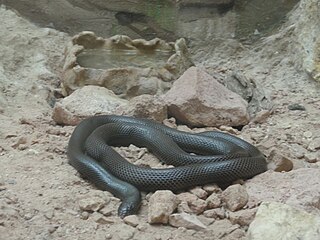
Atractaspis is a genus of venomous snakes in the family Lamprophiidae. The genus is endemic to Africa and the Middle East. The genus contains 15 species that are recognized by ITIS. Others recognize as many as 21 species. 23 are listed here.
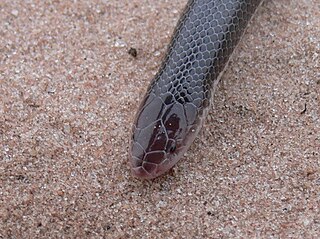
Atractaspis bibronii is a species of venomous snake in the family Atractaspididae. The species is endemic to Africa. There are no subspecies that are recognized as being valid.
Xenocalamus transvaalensis is a species of venomous rear-fanged snake in the family Atractaspididae. The species is endemic to Africa. There are no subspecies that are recognized as being valid.
The small-scaled burrowing asp is a species of atractaspidid snake from West Africa.

Atractaspis aterrima, commonly known as the slender burrowing asp or mole viper, is a species of fossorial, venomous snake in the family Atractaspididae. The specific epithet, aterrima, meaning "blackest", is the superlative form of the Latin adjective ater, meaning "black".
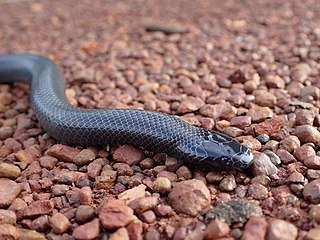
Atractaspis congica, commonly known as the Congo burrowing asp, is a species of venomous snake in the family Atractaspididae. It is found in Africa.
Atractaspis corpulenta, or the fat burrowing asp, is a species of snake in the Atractaspididae family. It is endemic to Africa.

Atractaspis irregularis, or the variable burrowing asp, is a species of venomous snake in the family Atractaspididae. It is found in Africa.
Atractaspis leucomelas, or the Ogaden burrowing asp, is a species of venomous snake in the Atractaspididae family.
Xenocalamus mechowii, or the elongate quill-snouted snake, is a species of venomous rear-fanged snake in the subfamily Aparallactinae of the family Atractaspididae. The species is endemic to Africa.
Leptotyphlops distanti, also known commonly as Distant's threadsnake or Distant's worm snake, is a species of snake in the family Leptotyphlopidae. The species is native to Southern Africa.
Leptotyphlops nigricans, also known as the black threadsnake or black worm snake, is a species of snake in the family Leptotyphlopidae. It is endemic to Africa.
Rhinotyphlops boylei, commonly known as Boyle's beaked blind snake, is a species of snake in the family Typhlopidae. The species is native to southern Africa.
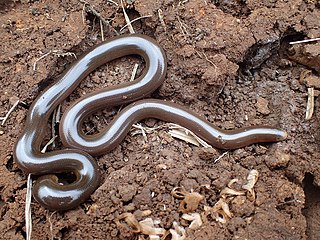
Bibron's blind snake is a species of snake in the family Typhlopidae. The species is native to southern Africa.

The black file snake, also known commonly as the dwarf file snake or the Nyassa file snake, is a species of snake in the subfamily Lamprophiinae of the family Lamprophiidae. The species is endemic to Africa.

The Namib chirping gecko, also known commonly as Carp's barking gecko, is a species of lizard in the family Gekkonidae. The species is endemic to Namibia.
Monopeltis capensis, also known commonly as the Cape spade-snouted worm lizard, the Cape wedge-snouted worm lizard, the Cape worm lizard, and the South African shield-snouted amphisbaenian, is a species of amphisbaenian in the family Amphisbaenidae. The species is native to southern Africa.
Monopeltis infuscata, also known commonly as the dusky spade-snouted worm lizard, the dusky worm lizard, and the infuscate wedge-snouted amphisbaenian, is a species of amphisbaenian in the family Amphisbaenidae. The species is indigenous to southern Africa.
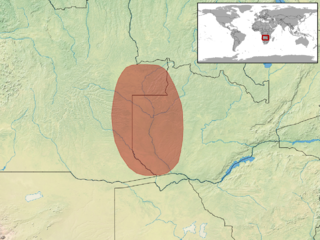
Zygaspis nigra is a worm lizard species in the family Amphisbaenidae. The species is endemic to southern Africa.
Typhlacontias punctatissimus, also known commonly as the dotted blind dart skink, the speckled burrowing skink, and the speckled western burrowing skink, is a species of lizard in the family Scincidae. The species is native to southern Africa. Three subspecies are recognized.










